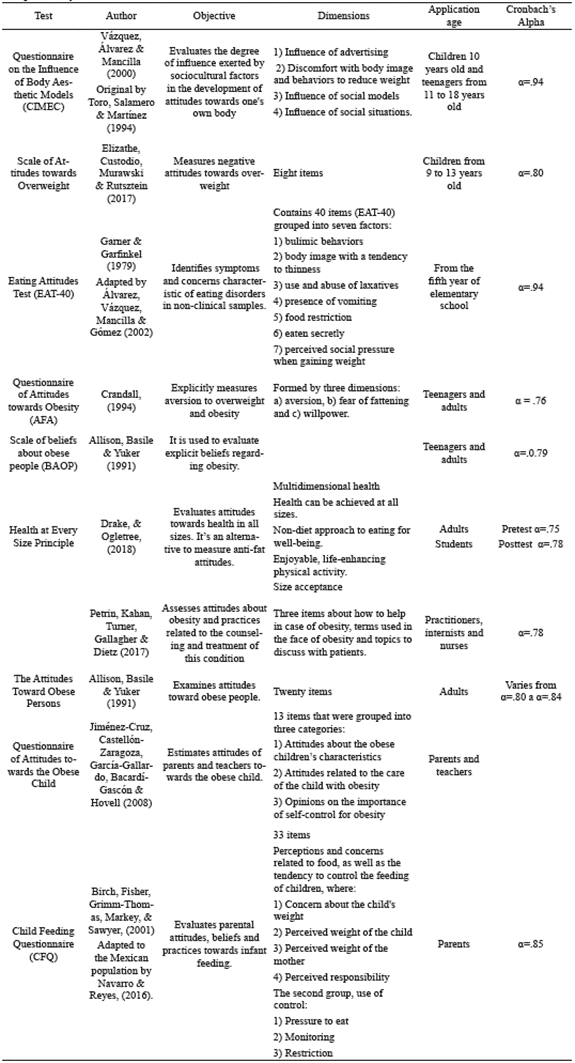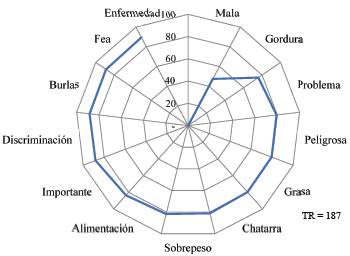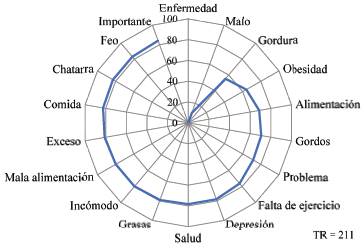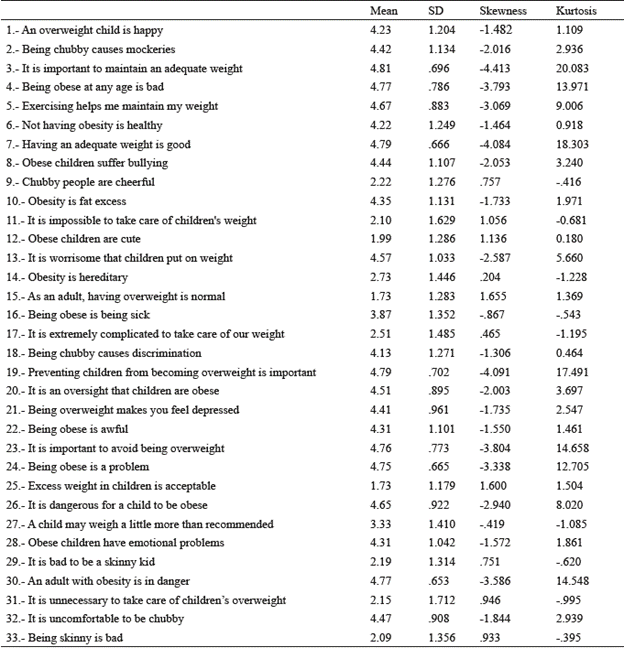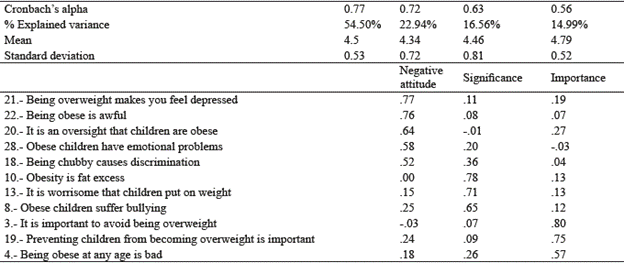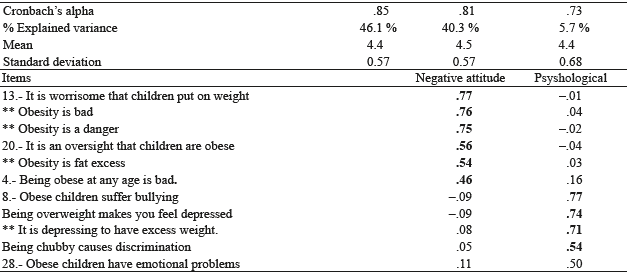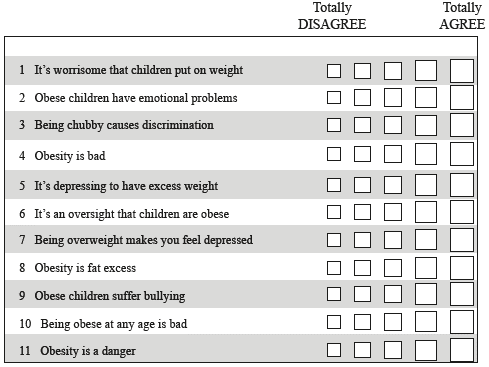Introduction
In the last three decades, the prevalence of obesity has seen an unprecedented increase worldwide and nationally (ENSANUT MC, 2016). In Mexico, the combined prevalence of overweight and obesity in the 5- to 11-year-old population decreased from 34.4% in 2012 to 33.2% in 2016; however, the difference was not statistically significant (Shamah-Levy et al., 2018). Obesity may increase the risk of diseases such as diabetes mellitus, hypertension, dyslipidemias, coronary diseases, osteoarthritis, different types of cancer (breast, esophagus, colon, endometrium and kidney) (Balagopal, 2006, Hernández & Martinez, 2011), insulin resistance, cardiovascular diseases, asthma, orthopedics, sleep apnea, fatty liver disease and acceleration of puberty in children (Lakshman, Elks & Ong, 2012; Stewart, 2010; Vega, 2011). On the other hand, there are psychosocial consequences like discrimination, social stigma, being a victim of bullying, having a bad body image, low self-esteem, stress, depression, anxiety, emotional consequences, eating behavior disorders and poor learning (Kar, Dube, & Kar, 2014; Ortega, 2018). Childhood is considered a critical period to carry out preventive measures (Bacardi, Jiménez, Jones & Guzmán, 2007); it is at this stage that a variety of risk factors involved in the etiology of childhood obesity are presented, particularly in children within the family context. Negative attitudes towards obesity have been associated with the incorrect belief about the causes of weight gain and the responsibilities of overweight by people and their families (Jiménez-Cruz, Castellón-Zaragoza, García-Gallardo, Bacardi-Gascón & Hovell, 2008). For Eagly and Chaiken (1993) attitudes are a psychological tendency expressed through the evaluation of a particular entity with some degree for or against it.
Colloquially, the term attitude is used to indicate that a person can have thoughts and feelings towards things or people that they like or dislike, attract, repel, etc. Attitudes tend to be reflected in the way individuals speak, act and behave in their relationships with others. It is one of the concepts most used in social psychology since it seeks to understand and explain human behavior (Coll, Pozo, Sarabia & Valls, 1994).
Attitudes have three components: cognitive, affective and behavioral. The cognitive component refers to the individual's perceptions and their beliefs, that is, their ideas about an object; the affective component includes the person's feelings with respect to the object, concept, person, etc., and the behavioral component consists of the tendency to act or react in a certain way with respect to the object (Eagly & Chaiken, 1993; Garcia, 2004). The complexity and strength of the components have important implications for the development and modification of an attitude. During childhood, especially when attitudes are acquired, the three components are very important. Over time, when the individual has reached a better integration of attitudes, these become more extreme and the cognitive component becomes more important.
Starting from the fact that attitudes are predispositions that will determine and direct the behavior of the person, people are expected to act in accordance with what they believe; however, attitudes and behaviors often show great discrepancies. Attitudes tend to be private and are subject to social pressure (Garcia, 2004). These three components act in a related manner and thus have to be treated in any approximation that tries to approach reality and explain what happens (Coll et al., 1994).
The importance of identifying the attitudes of mothers lies in the fact that they are, in most cases, the ones who make decisions regarding how and in what way they will feed their children. Getting to know the type of attitude toward obesity could provide the necessary information for designing interventions related to feeding practices and styles towards their children (Pettigrew, Jongenelis, Quester, Chapman & Miller, 2015).
Several authors have investigated the attitudes towards the prevention of obesity associated with the perception of barriers and parental support by the institutions (Vittrup & McClure, 2018).
There are several instruments that measure attitudes and beliefs towards obesity, mainly focused on mothers and very few on children. Table 1 shows a summary of them.
The relevance of the present study is that future research may evaluate the attitudes of mothers towards overweight and childhood obesity. It has been found that authoritarian paternity and beliefs about controllability are predictors of mothers' aversion to overweight adults (Holub, Tan & Patel, 2011). On the other hand, mothers' own fear of fat has been a predictor of anti-fat attitudes (Davison & Birch, 2004). Mothers who fear being overweight probably discuss their weight concerns or participate in dietary behaviors in front of their children. Research suggests that parents' anti-fat or negative attitudes towards obesity can influence the care they provide to their young children, especially in the field of infant feeding. Specifically, it has been found that mothers with negative attitudes about weight restrict or limit their children's food intake (Musher-Eizenman, Holub, Hauser & Young, 2007). In other studies, associations have been found between pediatric obesity, emotional states of mothers and their attitudes (Pekcanlar, Ozturk, Nur, Kavurma, & Tufan, 2015).
Therefore, the objective of this study was to design and validate a scale that evaluated maternal attitudes towards overweight and childhood obesity, which consisted of four studies: the first one was a qualitative study aimed at identifying the psychological meaning of overweight and obesity of mothers; the second comprised content validity through judges; the third consisted of the first validation and analysis of some inconsistencies; and the last study referred to the validation with a different sample and verification of their psychometric properties after adding and improving some items.
Exploratory study 1
Participants
As an inclusion criterion, it was requested that the tutors had a child or grandchild in kindergarten and that they were in charge of their feeding. Following these guidelines and through a non-probabilistic and intentional sampling, 95 mothers and 4 grandmothers of preschool children were selected. The age ranged from 20 to 54 years old (Mage = 32.29 years, SD .7.8). In the case of the children, their ages were from 3 to 6 years old (Mage = 4.5 years; SD .61) with a total of 44% girls and 56% boys.
Type of study
Qualitative, non-experimental, because it was carried out without deliberately manipulating the independent variables in order to see their effect on other variables, that is, they are measured in their natural context to analyze them. It is also cross-sectional because it was carried out in a single moment (Shaughnessy, Zechmeister & Zechmeister, 2007).
Instrument
Through the technique of Modified Natural Semantic Networks (RSNM) (Reyes-Lagunes, 1993), a series of oblate size sheets was used, which was divided into three sections: a) introduction, instructions and an example not related to the subject; b) presentation of the five stimuli ordered randomly, and c) general data. The stimuli used were: Overweight is; obesity is; body weight is; diet is; health is; and my weight is, as a distractor stimulus. Participants were instructed to write at least five loose words they associated to the stimulus word (overweight, obesity, diet, health and body weight). Subsequently, they were asked to rank the words according to the importance each word had with respect to the stimulus, so number one would be assigned to the most important word, number two to the second most important word and so on, until finishing the list.
Procedure
The corresponding permits were requested, the mothers and grandmothers were asked for their signed consent and the approval to answer the technique. The instrument, in most cases, was applied collectively and the average time spent was 15 minutes. Based on the protocol of Modified Natural Semantic Networks, first the total number of defining words or network size (NS) for each stimulus was obtained, then the semantic weight (SW), which depicts the importance assigned to each word in the representation of a concept, and finally the network core (NC) (Reyes-Lagunes, 1993).
Data analysis were performed using the Microsoft Office Excel 2010 program.
Results
For the purposes of this investigation, only the results of two stimuli are described; 1) Obesity is... and 2) Overweight is... For the stimulus Obesity is..., it was observed that the TR had187 definers, with a NR that starts with the definer "disease", followed by "bad", "fat", "problem", "dangerous", "fat" and "scrap". It is striking that obesity is defined as "overweight", later defined as "diet", "important", "discrimination", "teasing" and "ugly" (See Figure 1). On the other hand, for the stimulus Overweight is..., the TR consisted of 211 definers, having as first definer the word "disease". As in the obesity stimulus, overweight is considered a disease, followed by the definers: "bad", "fatness", "obesity", "food", "fat" and "problem". It should be noted that one of the relevant rules of semantic networks is that only words, phrases or sentences are requested. However, based on the repetition of these, it was decided to include "lack of exercise" and "poor diet". Later, mothers defined overweight as "excess", "food", "junk", "ugly" and "important", as shown in Figure 2. In general, it can be concluded that a series of definers with a significant negative connotation prevails.
Discussion
According to the results in both stimuli, overweight and obesity, the psychological meaning for mothers is that it is a disease, which denotes that there is a certain catastrophization of both concepts, as found by Olds, Thomas, Lewis & Petkov (2013), where some parents confused overweight and obesity; however, these concepts seem unrealistic given the opinions on the scope and speed of the increase in obesity rates. According to the World Health Organization (2018), overweight and obesity are defined as an abnormal or excessive accumulation of fat that can be harmful to health. Currently, the difference established between overweight and obesity is based on the measurement taken by the BMI (Body Mass Index) as established by the WHO (2018) where a BMI equal to or greater than 25 determines overweight and a BMI equal to or greater than 30 determines obesity.
On the other hand, the defining factors of each stimulus show a negative connotation. For mothers, obesity is a "disease" but not any disease; it is "bad", "fatness", "problem", "dangerous", "fat" and "junk". It is striking that obesity is defined as "overweight" and it was also found that it causes "discrimination", "teasing", as well as "uglyness". This corroborates studies where it is reported that obesity is implicitly associated with concepts that connote diseases, which may play a role in the stigmatization of obese people (Park, Schaller, & Crandall, 2007).
Study 2 Content validity
From the responses obtained in the study of semantic networks, 33 items were written. According to the test plan, the items were developed into four components; weight (health and illness), diet (type and quantity), physical activity (sedentary lifestyle and habits) and parents' responsability (nutrition and sedentary lifestyle). To obtain content validity, and through the judging process, a total of five judges who had knowledge and experience in the area were summoned; by means of a presentation the characteristics of the instrument were described to them; with a table of specifications they evaluated the items' sufficiency, clarity, relevance and coherence. For approximately two hours each of the items was discussed and when there was no agreement between the judges, decisions were taken by majority. In the end, changes were made according to the suggestions about the writing of the items, their clarity and relevance. Later, a pilot test was carried out with 15 mothers who had a preschool child, to verify that the instructions and items were clear. Changes were made to sociodemographic data errors. The validation of this instrument was carried out twice; the first validation with the respective characteristics of each sample is described as follows, as well as the place of the data collection.
Study 3 First validation
Participants
A non-probabilistic sample of intentional type was used, composed of 346 mothers whose age ranged from18 to 62 years old (M age = 33.08, SD = 6.8), with an educational level of elementary school (5.8%), junior high school (21%), high school (32.8%), bachelor's or technical degree (34.1%), master's degree (1.8%) and doctorate (.5%). 19.8% of mothers were single and 76% married. 42.5% of the mothers were employed, 30.8% were housewives and 27.2% worked in some trade such as merchant, cook or domestic worker . As an inclusion criterion, they were asked to have a preschooler child and another one in first year of elementary school, as well as being in charge of feeding them. Therefore, their children (48% boys and 52% girls) had an age range of 3 to 5 years (M age = 5.2, SD = 1.2), 76.3% were in preschool and kindergarten, 23.7% were in primary school, enrolled in public schools (84.3%) and private schools (15.7%) in Mexico City.
Type of study
Quantitative, non-experimental, because it was done without deliberately manipulating the independent variables to see their effect on other variables, that is, they are measured in their natural context to analyze them. It was also cross-sectional because it was carried out in a single moment (Shaughnessy, Zechmeister & Zechmeister, 2007).
Instrument
The instrument had a total of 33 items that made up four components: weight (health and illness), food (type and quantity), physical activity (habits) and parents' responsa-bility (diet and sedentary lifestyle). The response format was Likert type with five response options, ranging from Totally disagree (1) to Totally agree (5), as shown in figure 3.
Procedure
The application was carried out in public and private schools in Mexico City; consent was requested and the instrument was applied with the support of the principals, who gathered the mothers in the classroom, and these answered it in approximately 90 minutes. In other schools they were handed the instrument which was answered at home. Once the answers were captured, the psychometric validation was carried out following the criteria established by Reyes and Garcia (2008), which were:
a) Frequency analysis, measures of central tendency and dispersion by item, that is, the items that had a normal and biased distribution were identified: later it was found that all response options were attractive to all participants; b) analysis of the items' discriminative power through the Student t test and crosstabs. Two extreme groups were formed (high scores and low scores) that were contrasted to know if both groups were able to discriminate; c) factor analysis for each dimension through the principal component method with orthogonal rotation; items that did not meet the required specifications were debugged (score less than .40 and grouping in more than one dimension), and d) analysis of internal reliability by means of Cronbach's Alpha for each factor and scale in general.
Results
As a first step, frequencies, measures of central tendency and dispersion per items were obtained, as can be seen in Table 2. The results show that some items are above and below the theoretical average.
To verify the distribution of the items, it was found that most of them were negatively skewed, although items 9, 11, 12, 14, 15, 17, 25, 29, 31 and 33 were positively biased. For example, item 9 "Chubby people are very happy" presented a bias of .757, an average of 2.22 and a standard deviation of 1.27, which means that most responses accumulate in the first two options "Totally disagree" and "Disagree". At first glance they do not present a normal distribution given the bias they have. Subsequently, the Kolmogorov-Smirnov test was used, to verify normality. Ho was rejected (p ≤ 0,05) since the 33 items had a p value less than 0.05; therefore, the distribution was not normal.
Subsequently, a new variable was created, which grouped the extreme groups (obtained through the quartiles), the discrimination power was sought through the Student's t test in which the items 1, 9, 12, 14, 15, 17, 25, 27 and 29 were eliminated since they obtained a bilateral significance greater than .05. That is, there was no discrimination in both groups with these items. Subsequently, the Cronbach alphas were analyzed for the remaining items, so it was decided to eliminate items 11, 31 and 33, in order to obtain an acceptable alpha coefficient (α = .835). A Pearson correlation was performed and it was decided to use an orthogonal rotation due to the fact that low to moderate correlations were obtained.
The factorial analysis converged in 9 iterations, in which the items 32, 26 and 16 were eliminated, since these were located in two factors. Subsequent factor analyzes were performed and items 24, 7, 30, 23, 2, 5 and 6 were eliminated. These analyzes yielded three dimensions and a total of 11 items. A KMO score of .709 with a significance of .001 was obtained. Finally, reliability analysis was performed using Cronbach's alpha for all the items (α =.77) with a variance that explains 54.50% of the behavior. The first dimension belongs to the negative attitude (α =.72), the second dimension is called meaning (α =.63) and the third dimension is importance (α =.56). The variance explained by factor was 22.94% for factor 1, 16.6% for factor 2 and 14.99% for factor 3. Table 3 shows the final results of the scale.
Discussion
According to the results obtained in the first validation, it was found that the scale has acceptable psychometric properties, taking into account that it is the first one developed for Mexican mothers with their characteristics. It is important to emphasize that these results (especially the factor called Importance) have similarity with the factor attitudes related to attention to the child with obesity of the Questionnaire of Attitudes towards the Obese Child (Jiménez-Cruz, Castellón-Zaragoza, Garcia-Gallardo, Bacardi-Gascón & Hovell, 2008). However, when comparing the scale of the present research with that instrument, a factor that focuses on the consequences of obesity in children (generates depression, discrimination, emotional problems, etc.) was obtained in the scale, whereas the aforementioned questionnaire focuses on attitudes about the characteristics of the obese child, which denotes that children with this disease are characterized by being aggressive, lazy, sometimes express their feelings, etc. On the other hand, the scale lacks content validity, since there is a conjunction of items that belong to other factors such as items: "4.-Being obese at any age is bad" and "20.-It is an oversight that children are obese", which were grouped into the factor called Importance, and that, according to their structure, belong to the factor called Meaning only by exemplifying some items, although they are not the only ones. On the other hand, one of the limitations is that rigorous analyzes were not followed according to what was established by Lloret-Segura, Ferreres-Traver, Hernández-Baeza & Tomás-Marco (2014). That is, the bias and kurtosis were analyzed to verify the non-normal distribution of the test, which was corroborated through the Kolmogorov-Smirnov statistical test (that corresponded to the sample size). Subsequently, the Pearson product-moment correlation was used to decide the type of rotation (varimax), by means of the Maximum Likelihood Method (main components). However, the analysis provided the guidelines to improve the scale in relation to its items and the integration of new ones, which are described in Study 4.
Study 4 Second validation
Participants
A non-probabilistic sample of intentional type involved 369 mothers and grandmothers (3%) with an age range of 17 to 63 years old (M gge = 32.43, SD = 7.9), 18% of mothers were single, 45% were married, 33% in consensual union and 2% divorced. According to their educational level, 11% attended elementary school, 39% attended junior high school education, 23% had technical studies, 10% attended high school, 16% had a bachelor's degree, 5% had a master's degree and 5% had a doctorate. The inclusion criterion was having a child at preschool level and being responsible for their feeding, so 51% were boys and 49% girls, 15% were in the 2nd year of preschool and 85% in the 3rd year, all of them attending public schools in Mexico City.
Type of study
Quantitative, non-experimental, because it was done without deliberately manipulating the independent variables to see their effect on other variables, that is, they are measured in their natural context to analyze them. It was also cross-sectional because it was carried out in a single moment (Shaughnessy, Zechmeister & Zechmeister, 2007).
Instrument
The 11 items that had been obtained from the first validation were used, and some items were added in order to improve the wording. Information from the first study was taken and given to the same judges, who later analyzed and reviewed it. The following six items were added; "4.-Obesity is an important disease", "5.- It is depressing to have excess weight", "6.- Obesity is a disease", "8.-Obesity is a danger", "10.- Obesity is bad" and "13.-Being overweight is NOT serious". Figure 4 shows some examples.
Procedure
As with the initial validation, the consent was requested and the instrument was applied. Some mothers answered it at home, returning the instrument the next day. The statistical treatment was carried out with the previous steps; however, this study sought to verify the normal distribution of the items by means of the Kolmogorov-Smirnov test in order to make the best decisions later regarding the subsequent analyzes, which are described in the results below.
Results
According to the first validation step, frequency analysis, measures of central tendency and dispersion were performed, observing the items' attractiveness (that is, the answers were distributed in a balanced manner in the five response options). It was found that item 13 was the one that met this condition, having at least 10 responses in each option. On the other hand, the items were negatively biased, although the only item that did not meet this condition was item 13 (See Table 4). Subsequently, the Kolmogorov-Smirnov test was used to verify normality. Ho was rejected (p ≤0,05) since the 17 items had a p value lower than 0.05: therefore, the distribution was not normal.
Table 4 Means, standard deviation, bias and kurtosis of each item.
| Mean | SD | Skewness | Kurtosis | |
| 1. Obese children have emotional problems | 4.43 | .854 | -1.650 | 2.803 |
| 2.- Being obese at any age is bad | 4.59 | .867 | -2.627 | 7.168 |
| 3.- Being chubby causes discrimination | 4.48 | .936 | -2.074 | 4.150 |
| 4.- Obesity is an important disease | 4.72 | .692 | -3.248 | 12.178 |
| 5.- It is depressing to have excess weight | 4.44 | .902 | -1.799 | 3.047 |
| 6.- Obesity is a disease | 4.53 | .894 | -2.307 | 5.360 |
| 7.- Obesity is fat excess | 4.42 | .920 | -1.823 | 3.248 |
| 8.- Obesity is a danger | 4.76 | .607 | -3.431 | 14.741 |
| 9.- It is worrisome that children put on weight | 4.64 | .702 | -2.266 | 5.737 |
| 10.- Obesity is bad | 4.72 | .641 | -2.786 | 9.149 |
| 11. - Obese children suffer bullying | 4.63 | .771 | -2.580 | 7.314 |
| 12.- Being overweight makes you feel depressed | 4.45 | .946 | -2.015 | 3.882 |
| 13.- Being overweight is NOT serious | 1.91 | 1.487 | 1.342 | .116 |
| 14.- Being obese is awful | 4.19 | 1.127 | -1.397 | 1.218 |
| 15.- It is important to maintain an adequate weight | 4.75 | .830 | -3.631 | 12.603 |
| 16.- It is an oversight that children are obese | 4.36 | .968 | -1.660 | 2.544 |
| 17.- Preventing children from becoming overweight is important | 4.80 | .674 | -4.126 | 18.264 |
Subsequently, the discrimination power was determined by Student's t-test, in which it was found that item13 did not meet the appropriate conditions, since it obtained a bilateral significance greater than .05, therefore, it was eliminated. To continue with the exploratory factor analysis, and considering the characteristics of the items, that is to say, they are polycotomic (Likert type), have five response options and do not meet the normality assumption, the factor estimation method called Ordinary Least Squares (OLS) with ULS (underweight least squares) or unweighted was used. The OLS consists of the grouping of a series of descriptive methods that have as a common denominator to determine the factorial solution that makes the residuals as close to zero as possible. Considering the relationship between the factors, the oblimin rotation type was chosen as suggested by Lloret-Segura, Ferreres-Traver, Hernández-Baeza & Tomás-Marco, (2014).
In the factorial analysis, the items eliminated were: "6.-Obesity is a disease", "4.-Obesity is an important disease" and "14.- Being obese is awful", because they had a saturation level of less than .40, and the items "15.- It is important to maintain an adequate weight" and "17.-Preventing children from becoming overweight is important ", because they were presented as a factor (at least three are required to form one). According to this analysis, a .900 with ap .000 in the KMO score and Bartlett's test was obtained. The scale was two-dimensional, with a total test reliability of α =.85, an explained variance of 46.12%, for factor one (α =.81), a variance of40.38%, for factor two (α =.73) and an explained variance of 5.74%. The psychometric properties can be seen in Table 5.
After the results in both scales, the second scale showed a good internal consistency by Cronbach's Alpha (α =.85). In addition, the items show content validity, that is, they were adapted to the name of the factors (negative attitude and psychological consequences). To verify the scale's factorial structure, it is recommended to perform a confirmatory factor analysis in a sample with similar characteristics.
Discussion
According to the review and analysis of the scales found in the literature, it was evident that most of them are focused on measuring attitudes towards people who suffer from overweight and obesity, but not necessarily focus on the disease as such; they generally assess attitudes towards people's characteristics with this condition, the behaviors that describe the problems, and the concerns related to the disease (Allison, Basile & Yuker, 1991; Crandall, 1994; Jimenez-Cruz, Castellón-Zaragoza, García-Gallardo, Bacardí-Gascón & Hovell, 2008). On the other hand, there are studies that have analyzed the attitudes of parents in a descriptive way, which reflects the importance of developing a scale to measure these attitudes (Njelekela, Muhihi, Mpembeni, Anaeli, Chillo, Kubhoja, Lujani, Ngarashi & Maghembe, 2015).
In the case of scales directed to parents, they are related to overweight prevention, in the way they provide healthy food and beverages, as in the study by Pettigrew, Jongenelis, Quester, Chapman & Miller, (2015), who found that parents have a positive attitude when food is associated with the enjoyment of their children, that is, the taste and how convenient it is for them to buy it (monetary value). In the results obtained in the first validation, three factors were obtained: negative attitude, meaning, and finally, importance of overweight and childhood obesity. However, the items were combined in all three factors, which generated confusion at the time of naming them.
In the end, a scale consisting of 11 items grouped into two factors was obtained; the first, called "negative attitude" and the second, "psychological consequences". The response means of each factor indicate that the sample reports a negative attitude towards overweight and childhood obesity, in addition to agreeing on the consequences of overweight in children, mainly at the emotional level, as reported by Sahoo, Sahoo, Kumar, Yasin, Kumar & Singh (2015).
The scale is focused on evaluating the attitudes of mothers towards overweight and childhood obesity; however, several authors have evaluated negative attitudes towards obese people explicitly and implicitly (Schwartz, Vartanian, Nosek & Brownell, 2006). The present research makes an evaluation of negative attitudes explicitly, since people consciously admit the answers given. Cárdenas & Barrientos (2008) consider that in order to evaluate attitudes, it is necessary to have items that contain implicit answers, since they usually serve to give automatic and rapid responses, where the true attitude of the participant is revealed.
Although the present scale has acceptable psychometric properties, it is recommended to continue analyzing its consistency and specially to perform a confirmatory factor analysis. This scale will set the tone for studies that help understanding the influence of negative maternal attitudes towards overweight in relation to the type of parental feeding practices carried out by mothers, as found in previous studies (Davison & Birch, 2004; Musher-Eizenman, Holub, Hauser & Young, 2007), as well as to analyze the relationship between the mothers' self-efficacy and feeding behaviors associated with the eating behaviors of their children (Chen, Guo, Esquivel & Chesla, 2017).
Children's health is currently a critical issue, but if the factors of the mothers associated with the factors of their children are recognized, this will be an important first step to understand and deal with this problem. The design and adaptation of instruments allow appreciating the relationship of variables and explaining the development of some behaviors, which will enable the creation of interventions to promote healthy lifestyles and thus prevent overweight and obesity.











 texto en
texto en 

